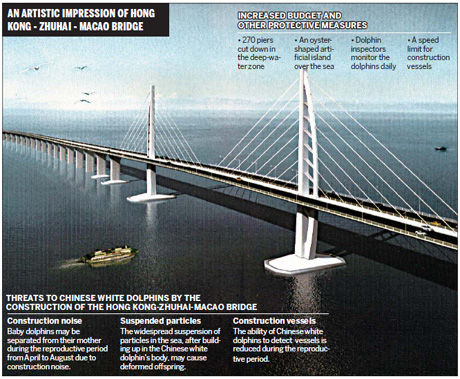Mating calls to be answered
The construction of a section of the Hong Kong-Zhuhai-Macao Bridge, which will run through the Chinese white dolphin national nature reserve in the Pearl River estuary, has received the go-ahead to proceed conditionally during the breeding season, which will cost an extra 3.67 billion yuan ($541million).

Experts organized by the office for the protection of aquatic wild animals and plants under the Ministry of Agriculture assessed the situation late last month and approved a report on the preliminary design of the project as it affects the reserve.
The report proposed amendments to the scheme regarding the design of the bridge, the tunnel, the artificial island and the method of construction to protect the endangered species, according to Guangzhou Daily.
According to the revamped scheme, the arch of the bridge over deeper sections of the Pearl River Estuary is to be expanded from 70 meters to 110 meters to reduce the number of piers and provide more room for the dolphins to swim.
Over shallower water, the arch of the bridge is to be similarly expanded from 70 to 85 meters.
The report details technological requirements, construction techniques, supervisory methods and safety measures to minimize the impact of building the bridge during the dolphins' breeding season, the Hong Kong-based Ta Kung Pao newspaper cited experts concerned with the project as having said.
The amendments to the scheme, which need to be approved by the relevant departments in the central government, aim to ensure the completion of the bridge by the end of 2016, which is expected to incur a further cost of 3.67 billion yuan on the 72.6 billion yuan project.
Previously, the Ministry of Agriculture ruled in 2008 that no construction was to take place on the bridge between April and August every year, which is the Chinese white dolphins' breeding season.
The ruling was expected to extend the time required to complete the bridge, the world's longest cross-sea span with a total length of almost 50 km, by three years.
Construction of an artificial island for the bridge began late last year and major work on the bridge is expected to start later this year.
The amount of noise and debris produced in the construction of the bridge may affect the dolphins, which rely on the use of echo location to move about in the water, said Qiu Yongsong, the South China Sea Fisheries Research Institute under the Chinese Academy of Fishery Sciences.
Experts have yet to determine the impact the traffic and redistribution of water will have on the species once the bridge is completed, Qiu said.
The Chinese white dolphin, an endangered species, falls under the highest class of protection in China. While its habitats include the sea along Xiamen in Fujian province, the Guangxi Zhuang autonomous regions and Leizhou Bay in Guangdong, it is concentrated in the area of the Pearl River estuary, said Chen Tao, a researcher with the South China Seas Fisheries Research Institute.
Over recent years, the species has continued to decline around the estuary to about 2,500 in number.
A total of 103 Chinese white dolphins ran aground and died in this area between 2003 and 2009, including 37 in Guangdong province, 63 in Hong Kong and three in Macao.
In 2009, 22 dolphins perished and three have died so far this year, the Southern Metropolis Daily reported.
 0
0 






